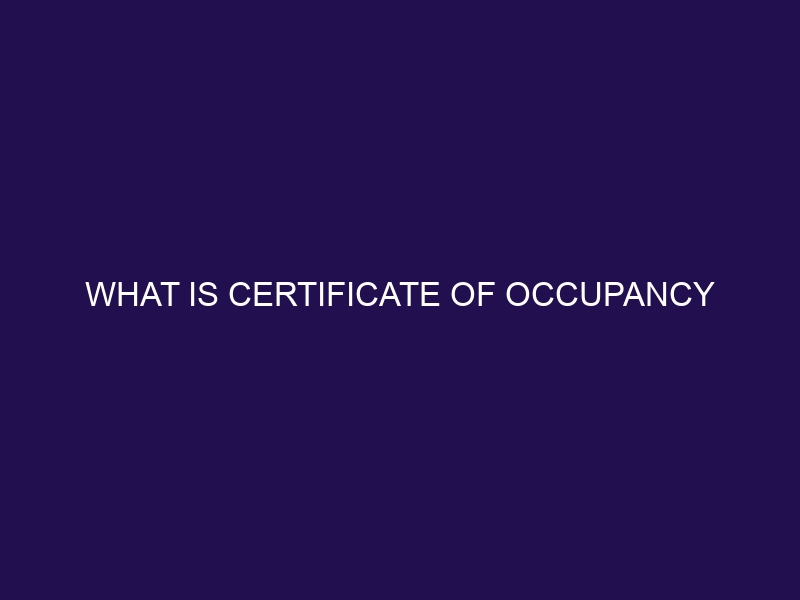What is Certificate Of Occupancy
A Certificate of Occupancy (CO) is an official document issued by a government agency or building department that certifies a building or structure is safe and suitable for occupancy. This article will delve into the details of what a Certificate of Occupancy entails.
The purpose of a Certificate of Occupancy is to ensure that a building meets specific building codes, regulations, and safety standards. It serves as proof that a building is compliant with zoning laws, has proper building permits, and has undergone necessary inspections.
The Certificate of Occupancy is typically issued by the local government or building department. It is the responsibility of these authorities to inspect a building during various stages of its construction or renovation to ensure it meets all the necessary requirements.
A Certificate of Occupancy is required in situations such as the construction of a new building, change of use of an existing building, or substantial renovations. It serves as documentation that the property is suitable for its intended purpose and can be legally occupied.
The contents of a Certificate of Occupancy include information about the property, details about the approved use of the property, building inspection results, and confirmation of compliance with building codes and regulations. It provides important information about the building’s safety features and any restrictions or limitations imposed on its use.
Having a Certificate of Occupancy is crucial for several reasons. Firstly, it ensures legal compliance, preventing any potential legal issues or penalties for occupying a building without proper authorization. Secondly, it ensures the safety and habitability of the property, protecting the occupants from potential hazards. Lastly, a Certificate of Occupancy is often required for property valuation and insurance purposes.
To obtain a Certificate of Occupancy, several steps must be followed. These include obtaining building plan approval, undergoing construction and inspections, conducting a final inspection, and submitting an application for approval. Once all requirements are met, the local government or building department will review the application and issue the Certificate of Occupancy if everything is in order.
What is a Certificate of Occupancy?
A Certificate of Occupancy, also known as a C.O., is an official document that provides assurance that a building or structure is deemed safe for occupancy by individuals. This significant document is issued by the local government or building department following a meticulous inspection to ensure strict adherence to building codes and regulations. By obtaining a Certificate of Occupancy, it is confirmed that the building satisfies all necessary safety requirements, encompassing essential aspects such as fire exits, electrical systems, plumbing, and overall structural soundness. It is imperative to prioritize the verification of a valid Certificate of Occupancy when considering purchasing or renting a property, as this ensures both the safety and legality of the structure. Always remember to request and authenticate the authenticity of the Certificate of Occupancy with the relevant local authorities to ensure your well-being. Make informed choices to secure a safe and suitable new home or workspace.
What is the Purpose of a Certificate of Occupancy?
The purpose of a Certificate of Occupancy (CO) is to ensure that a building or property meets the necessary safety and building code requirements for occupancy. It serves as proof that a structure is suitable for its approved use and is in compliance with regulations. The CO includes information about the property, approved use, building inspection results, and compliance with building codes. Obtaining a CO is important as it ensures legal compliance, ensures safety and habitability for occupants, and is necessary for property valuation and insurance purposes. It is obtained through a process that involves building plan approval, construction and inspections, and final inspection and application.
Who Issues the Certificate of Occupancy?
The Certificate of Occupancy is typically issued by the local government authority responsible for building regulations. This authority can vary depending on the location. In most cases, it is issued by the building department or the department of building inspections. These departments have the expertise to ensure that the building meets all the necessary safety and building code requirements before it can be occupied. They conduct inspections throughout the construction process to ensure compliance. Once the inspections are complete and all requirements are met, the department issues the Certificate of Occupancy, allowing the building to be occupied legally.
The Certificate of Occupancy has a long history and has been a crucial document in ensuring the safety and habitability of buildings. It dates back to the early 20th century when cities started implementing building codes and regulations to prevent fire hazards and ensure public safety. In the United States, the party responsible for issuing the Certificate of Occupancy varies from state to state and even within municipalities. Nevertheless, it has become an essential document in the real estate industry, protecting buyers and ensuring properties meet all necessary regulations.
When is a Certificate of Occupancy Required?
- A Certificate of Occupancy is required when constructing new buildings or structures.
- A Certificate of Occupancy is required when making changes or renovations to existing buildings that affect its use or occupancy.
- A Certificate of Occupancy is required when converting a space from one use to another, such as from residential to commercial.
- A Certificate of Occupancy is required when a property has been vacant or not in use for a certain period of time.
- A Certificate of Occupancy is required when there is a change in ownership or transfer of property.
- A Certificate of Occupancy is required when there is a change in the occupancy classification of a building, such as from single-family to multi-family.
What Does a Certificate of Occupancy Include?
Curious about what a Certificate of Occupancy includes? Let’s dive into the details! We’ll uncover valuable information about the property, approved use, building inspection results, and compliance with building codes and regulations. From the nitty-gritty property specifics to meeting the necessary standards, this section has got you covered. So, buckle up and prepare to unravel the essential components of a Certificate of Occupancy!
Information about the Property
When it comes to obtaining a Certificate of Occupancy, it is crucial to understand all the information about the property it includes. This information plays a vital role in ensuring legal compliance, safety, and accurately valuing the property. The Certificate of Occupancy provides comprehensive details such as the approved use of the property, building inspection results, and adherence to building codes and regulations. Having this certificate ensures that the property meets all necessary requirements for occupancy. Let me share a true story that emphasizes the significance of this information. Once, a family unknowingly purchased a property without being aware of the restrictions on its commercial use. This unfortunate oversight resulted in severe legal issues and significant financial losses. Therefore, it is absolutely essential to grasp the information presented in the Certificate of Occupancy for any real estate transaction.
Approved Use of the Property
When it comes to obtaining a Certificate of Occupancy, the approved use of the property is a crucial factor to consider. This information ensures that the property is being utilized in compliance with its approved purpose and zoning regulations. Here are some key points to understand about the approved use of the property:
- 1. Zoning and Regulations: The approved use of the property is determined by the local zoning regulations and land use restrictions.
- 2. Commercial or Residential: The property may be designated for commercial, residential, or mixed-use purposes.
- 3. Specific Use: The approved use may specify the type of business or activities allowed on the property.
- 4. Limitations: There may be restrictions on certain activities or operations that are not permitted on the property.
- 5. Compliance: The property owner must adhere to the approved use to maintain the validity of the Certificate of Occupancy.
When it comes to the Certificate of Occupancy, the approved use of the property plays a vital role. The property’s approved use is determined by the local zoning regulations and land use restrictions, ensuring compliance with its designated purpose. In terms of the approved use of the property, there are several key factors to comprehend:
- 1. Zoning and Regulations: The approved use of the property is bounded by the local zoning regulations and land use restrictions.
- 2. Commercial or Residential: The property can be assigned for commercial, residential, or mixed-use purposes.
- 3. Specific Use: The approved use may include specific guidelines regarding the type of business or activities permitted on the property.
- 4. Limitations: Certain activities or operations may be restricted and not allowed on the property.
- 5. Compliance: To maintain the validity of the Certificate of Occupancy, it is crucial for the property owner to abide by the approved use.
Building Inspection Results
The Building Inspection Results section of a Certificate of Occupancy provides important information on the property’s compliance with building codes and regulations. It plays a vital role in ensuring that the property meets safety and habitability standards. This section contains detailed records of the inspections conducted throughout the construction process, covering aspects such as structural integrity, electrical systems, plumbing, fire safety measures, and more. It specifically outlines any deficiencies or violations discovered during these inspections and indicates whether they have been rectified. The Building Inspection Results hold significant value in evaluating the overall quality and safety of the property, offering reassurance to both occupants and potential buyers.
Compliance with Building Codes and Regulations
Compliance with building codes and regulations is an essential requirement when obtaining a Certificate of Occupancy (CO). It is imperative for property owners to strictly follow local construction guidelines and regulations established by the authorities. Adhering to these rules ensures that the property meets all necessary codes related to structural integrity, fire safety measures, electrical systems, plumbing, and accessibility. Throughout the construction process, inspections are conducted to evaluate compliance with these building codes and regulations. Successfully obtaining a CO confirms that the property fully complies with all the required codes and regulations, guaranteeing the safety and livability of the building. Compliance with building codes and regulations is of utmost importance in order to avoid legal penalties and protect both the property owner and occupants.
Why is a Certificate of Occupancy Important?
In the world of real estate, a Certificate of Occupancy (CO) holds significant importance. It serves as a key document that ensures legal compliance, guarantees safety and habitability, and even affects property valuation and insurance. Digging deeper into these aspects, we’ll uncover how a CO acts as a crucial indication of a property’s adherence to regulations, making it a vital piece of documentation for both property owners and potential buyers.
Legal Compliance
When it comes to Legal Compliance, adhering to a Certificate of Occupancy (CO) is of utmost importance. Obtaining a CO ensures that a property meets all the necessary building codes, regulations, and safety standards mandated by local authorities. This document acts as proof that the property is fit for habitation or use and is legally compliant. It is crucial to carefully review and follow all building codes and regulations to ensure legal compliance and avoid legal issues, fines, and potential hazards. To achieve this, it is recommended to work closely with professionals like architects, contractors, and inspectors throughout the construction process.
Ensures Safety and Habitability
Ensuring safety and habitability is a crucial aspect of obtaining a Certificate of Occupancy. Here are three reasons why this certificate is important in terms of ensuring safety and habitability:
- Legal Compliance: A Certificate of Occupancy verifies that the property meets all the necessary safety regulations and building codes, ensuring safety and habitability. This ensures that the building is safe for occupancy and minimizes potential hazards.
- Ensures Safety: By obtaining a Certificate of Occupancy, it guarantees that the property has undergone thorough inspections, including fire safety, electrical wiring, plumbing, and structural stability, to ensure the safety of its occupants and habitability.
- Property Valuation and Insurance: Having a valid Certificate of Occupancy increases the value of the property and allows for easier property insurance coverage, as it demonstrates that the property meets safety standards ensuring safety and habitability.
Property Valuation and Insurance
Property valuation and insurance are two crucial elements when it comes to acquiring a Certificate of Occupancy (CO). The CO serves as an official acknowledgment of a property’s compliance with building codes and regulations, guaranteeing its safety and livability. This documentation plays a vital role in assessing the value of a property since it signifies that all necessary requirements have been met. Insurance companies frequently mandate a CO before providing coverage for a property, as it serves as evidence of the property being in a satisfactory state. Accordingly, obtaining a CO is indispensable for both property valuation and insurance purposes.
How to Obtain a Certificate of Occupancy?
Discovering how to obtain a Certificate of Occupancy is a crucial step for property owners. This section unravels the process, from securing building plan approval to navigating construction inspections, culminating in the final inspection and application for a Certificate of Occupancy. We’ll explore the key stages and requirements involved, shedding light on the meticulous approval and issuance procedure. So, let’s dive into the journey of obtaining this important document for your property.
Building Plan Approval
Building Plan Approval is an essential step in acquiring a Certificate of Occupancy. Follow these steps to obtain it:
-
Prepare the building plans and submit them to the local building department for Building Plan Approval.
-
Ensure that the plans align with all applicable building codes and regulations for Building Plan Approval.
-
Pay any necessary fees for the review and approval of the plans related to Building Plan Approval.
-
Wait for the building department to thoroughly review and grant Building Plan Approval for the plans.
-
Address any comments or modifications requested by the building department to ensure Building Plan Approval.
-
Once the plans receive Building Plan Approval, obtain the required permits for construction.
The practice of requiring Building Plan Approval dates back to ancient civilizations when city authorities would assess construction plans to ensure compliance with building standards and structural integrity. This tradition continues today to promote safety and guarantee that buildings are constructed following regulations.
Construction and Inspections
Construction and inspections are vital aspects of obtaining a Certificate of Occupancy. The process involves several steps to ensure the safety and compliance of the property. Here is an overview of the construction and inspection process:
| Step 1: Building Plan Approval | Submit detailed construction plans to the local building department for review and approval. |
| Step 2: Construction and Inspections | Engage in the construction process, adhering to approved plans. Inspections are conducted at various stages to ensure compliance with building codes. |
| Step 3: Final Inspection and Application | Once construction is complete, a final inspection is scheduled to verify that the property meets all safety and regulatory requirements. |
| Step 4: Approval and Issuance | If the property passes the final inspection, the local building department will issue the Certificate of Occupancy, allowing the property to be legally occupied. |
Construction and inspections play a crucial role in obtaining a Certificate of Occupancy as they ensure that the property is built according to approved plans and meets all safety standards.
Final Inspection and Application
To complete the process of obtaining a Certificate of Occupancy, there are several steps involved in the final inspection and application. Here is a list of these steps:
- Ensure that all construction work has been completed according to approved plans and building codes.
- Schedule a final inspection for the Final Inspection and Application with the appropriate building department or authority.
- Prepare all required documentation, such as completion certificates and compliance reports, for the Final Inspection and Application.
- Submit the application for the Final Inspection and Application, along with any relevant fees.
- During the final inspection for the Final Inspection and Application, ensure that the property complies with safety and habitability standards.
- If any issues are identified during the final inspection for the Final Inspection and Application, address them promptly and provide necessary remedies.
- Once the property passes the final inspection for the Final Inspection and Application, a decision will be made regarding the Certificate of Occupancy.
- If approved, the Certificate of Occupancy will be issued, indicating that the property is suitable for occupation.
Approval and Issuance
“`
- Submit the final inspection and application: Once all construction work is completed and building inspections have been passed, you need to submit the final inspection report and application for the Certificate of Occupancy in order to initiate the process of approval and issuance.
- Review and evaluation: The building department will carefully review the submitted documents and conduct a thorough evaluation to determine if all requirements and codes have been met for the approval and eventual issuance of the Certificate of Occupancy.
- Approval: If everything is found to be in compliance with the regulations, the building department will grant its approval, giving the green light for the subsequent step of issuance of the Certificate of Occupancy.
- Issuance of the Certificate: Once the approval is obtained, the building department will proceed with the issuance of the Certificate of Occupancy, demonstrating that the property is compliant and safe for occupancy.
Pro-tip: To streamline the approval and issuance process, it is crucial to ensure that all required documents and inspections are completed prior to submitting the final application.
Frequently Asked Questions
What is a Certificate of Occupancy?
A Certificate of Occupancy (CO) is a legal document that confirms a property’s compliance with applicable laws and regulations, and its suitability for occupancy. It verifies that the property meets housing and building codes, and specifies the permitted occupancy and type of structure.
When is a Certificate of Occupancy necessary?
A CO is necessary for new construction projects, major renovations, or when there is a change in the use of a property. It is also required by buyers before purchasing a property, and may be needed when adding onto or making alterations to the property.
Who is responsible for obtaining a Certificate of Occupancy?
Sellers are typically responsible for obtaining the CO and bearing the cost. However, the specific responsibility may vary depending on local regulations and agreements between buyers and sellers.
How can I obtain a Certificate of Occupancy?
To obtain a CO, individuals can visit their local building information system’s website and fill out an application. A small fee may be required. The property must pass inspections before a CO can be issued.
What are the consequences of not having a Certificate of Occupancy?
Without a valid CO, occupying a property may be considered illegal. It may also affect the ability to close on a mortgage, rent out a property, or sell a property. Local government agencies may issue fines or penalties for non-compliance.
How can I check if a Certificate of Occupancy has been issued for a property?
To check if a CO has been issued for a property, you can use the Buildings Information Search in the Buildings Information System (BIS) or the Address search in the DOB NOW system. If a CO has been issued, it can be printed from the respective system.







